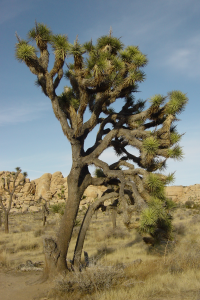Yucca brevifolia is a monocot in the Lily family. Joshua Tree got its common name from Mormons, who thought the outstretched branches resembled Joshua in prayer. It is thought that the Shasta ground sloth was the primary dispersers of the fruits of Joshua Tree before they went extinct. This species is pollinated by the Yucca moth, which spreads pollen and fertilizes flowers while in the process of laying its eggs inside the flower. The larvae then hatch in the fruit and feed on the seeds. So, while the Joshua tree depends on the moth to for reproduction, the moth also can hurt the plant’s ability to reproduce.
Photo Credit: © Nyenyec via Wikimedia Commons
Yucca brevifolia
Common Name: Joshua tree
Other Common Names: Izote de desierto
Plant Functional Group: Evergreen broadleaf
Class > Order > Family: Magnoliopsida > Asparagales > Asparagaceae
What does the species look like?
It is tree-like with a thick trunk and can be up to 40 feet tall. The leaves are evergreen and linear, up to 14 inches long, and taper to a sharp point. The flowers are creamy white, 2.5 inches long, and bell shaped. They are monoecious, having separate male and female flowers on the same plant. Flowers are found in tight clusters at the end of stalks.
Where is the species found?
States & Provinces
AZ, CA, NV, UT
Which phenophases should I observe?
Do you see...?
Flowers
Flowers or flower buds More...
How many flowers and flower buds are present? For species in which individual flowers are clustered in flower heads, spikes or catkins (inflorescences), simply estimate the number of flower heads, spikes or catkins and not the number of individual flowers.
Less than 3 3 to 10 11 to 100 101 to 1,000 1,001 to 10,000 More than 10,000
Open flowers More...
What percentage of all fresh flowers (buds plus unopened plus open) on the plant are open? For species in which individual flowers are clustered in flower heads, spikes or catkins (inflorescences), estimate the percentage of all individual flowers that are open.
Less than 5% 5-24% 25-49% 50-74% 75-94% 95% or more
Fruits
Fruits Yucca brevifolia , the fruit is a spongy capsule that changes from fleshy green to leathery tan, grayish-brown or brown, sometimes the skin cracking to expose the seeds. Do not include empty capsules that have already dropped all of their seeds.More...
How many fruits are present?
Less than 3 3 to 10 11 to 100 101 to 1,000 1,001 to 10,000 More than 10,000
Ripe fruits Yucca brevifolia , a fruit is considered ripe when it has turned leathery tan, grayish-brown or brown. Do not include empty capsules that have already dropped all of their seeds.More...
What percentage of all fruits (unripe plus ripe) on the plant are ripe?
Less than 5% 5-24% 25-49% 50-74% 75-94% 95% or more
Recent fruit or seed drop More...
How many mature fruits have dropped seeds or have completely dropped or been removed from the plant since your last visit?
Less than 3 3 to 10 11 to 100 101 to 1,000 1,001 to 10,000 More than 10,000
What do these phenophases look like?
There is currently no photoguide available for this species. If you'd like help us create one, use the guidance document and species template provided here . Then send it via email to education@usanpn.org when it is complete.
